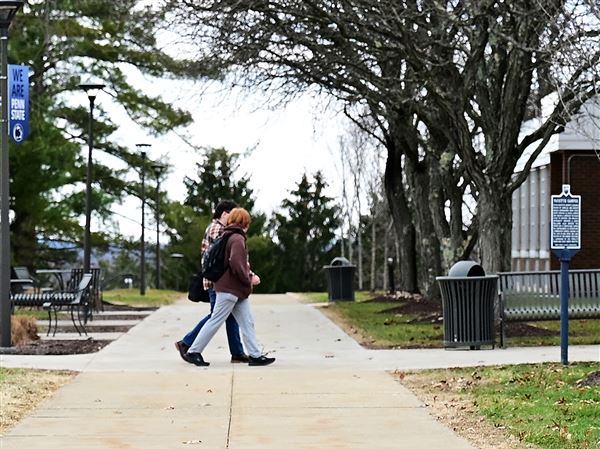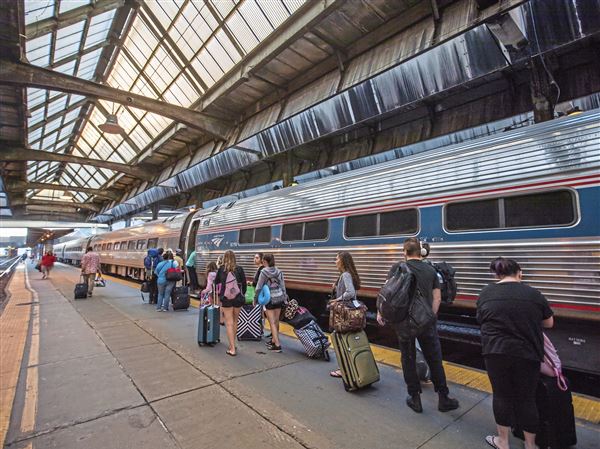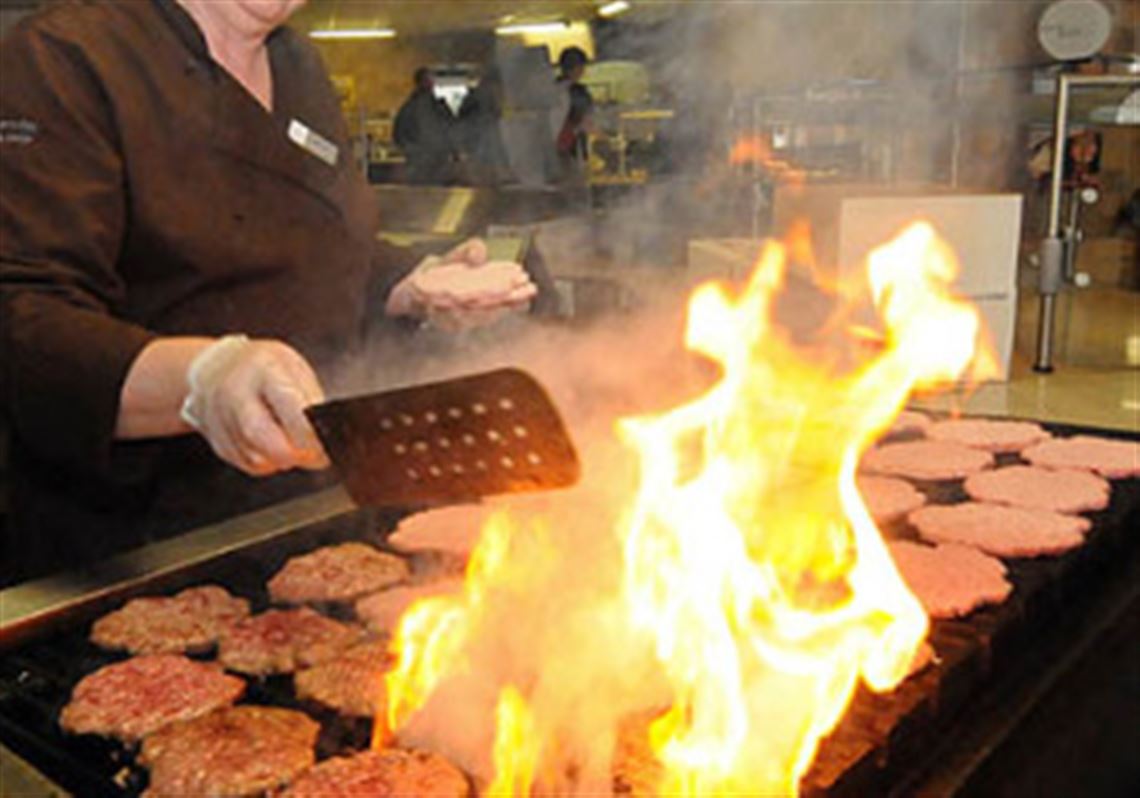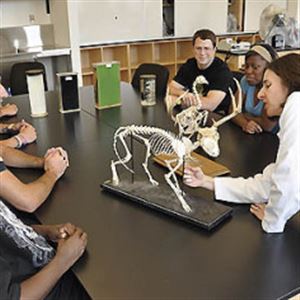SHIPPENSBURG, Pa. -- At first glance, it looked as if students attending the state university in this town had gotten off cheap.
Their tuition back in 2006 was going up a mere $132 or 2.7 percent, thanks to a vote by the board of governors overseeing Shippensburg University and the rest of the State System of Higher Education.
But that same year, an even bigger increase for Shippensburg students loomed -- a $320 boost in meal plan prices to be phased in over three years.
That's because the school wanted to turn its run-down and overcrowded dining hall into an airy, restaurant-style venue suitable for demonstration cooking, but it had no cash on hand for the work. So it borrowed the full $18 million and began paying it off through higher student meal plan fees.
Just like that, another of Pennsylvania's 14 state-owned universities became a bit more attractive to students expecting upscale amenities. And just like that, the State System moved deeper into debt.
From California to Kutztown, from Edinboro to East Stroudsburg, a building boom spanning more than a decade has produced trendy suite-style student residences, sleek classrooms and performance halls -- even a just-opened student center at Slippery Rock University whose front exterior wall is adorned with a half-million-dollar waterfall.
But on some campuses there is growing concern that the State System is mortgaging its future, saddling itself with ever-growing debt and its students with ever-rising fees.
The State System puts its debt total officially at $942 million, double what it was a decade ago. But after factoring in privately financed student housing and other projects built by university-affiliated groups -- a sum estimated by Moody's Investors Service to be nearly $1 billion -- total debt associated with the 14 universities is closer to $2 billion.
Data reviewed by the Pittsburgh Post-Gazette show the rate of campus borrowing has soared since 2002. It's up nearly ninefold at Cheyney University, almost eightfold at California University of Pennsylvania, sevenfold at Millersville University and fivefold at Shippensburg, among others.
The bulk of the borrowing is for nonclassroom projects such as student centers, dining halls and student residences, which are not eligible for state funds and thus are supported by student fees.
Campus officials say in many cases they had to replace 1960s-era buildings that were wearing out. And they note that higher student fees for the new venues -- filled with dance studios, food courts and attractions like a room in Shippensburg's student union devoted to Xbox360, Playstation3 and Wii -- often are approved in advance by student votes.
But Thomas Mortenson, a higher education policy analyst, said it's all part of what he considers a disturbing trend on college campuses nationwide -- the hunt to win over students at all costs at a time when affordability is a deepening worry.
"If we're building climbing walls and swimming pools and dorms with plush carpeting and private bathrooms, yet over half the students heading into higher education are not able to pay the first dollar, how are we going to make this system work?" asked Mr. Mortenson, senior scholar at the Pell Institute in Washington.
For years, it was hard to question the borrowing and building. After all, the State System was achieving year after year of record enrollments, a trend aided by the wow-factor of the new buildings.
At CalU, construction was one piece of a broad strategy to recruit more and better students that yielded enrollment gains of 45 percent in a decade -- best in the State System -- and successive freshmen classes whose average SAT scores improved from 945 to 1028. Being the first of the 14 universities to replace traditional dorms with $125 million worth of suite-style apartments gave then-CalU president Angelo Armenti Jr. an edge attracting students put off by two-per-room accommodations with group shower stalls.
CalU couldn't fill the old dorms, he said in a 2009 interview, but the new suites "have been 100 percent occupied since the day we opened them."
Now, though, the economy is weaker, the state has slashed the system's appropriation by 20 percent, and an expected enrollment decline means fewer students could be shouldering the fees.
CalU, facing a 9 percent enrollment drop this fall, still had vacancies in its new dorms days before classes began. Mounting debt for projects from parking facilities to a new $59 million convocation center was one of the issues that roiled campus in the months before the State System fired Mr. Armenti without explanation in May.
CalU collected $19 million in state grants to build the controversial center with its arena for 6,000 people and persuaded the State System to float $38 million in debt, even though CalU itself kicked in just $2 million.
Some parents like James Yeamans, 52, a Slippery Rock employee who has enrolled two sons in State System schools, believes the amenities have gone too far. The fact students approve the fee increases beforehand holds little sway with him.
"Why wouldn't they vote 'yes?' " he asked.
"A kid walks into a showroom and he heads right for the most expensive Corvette, saying 'Daddy, that's the one I want.' It's the adult's job to walk him over to the model he can afford."
"I'm all for making improvements, but when you see this building of castles when we could have built something a bit more practical, that's where I think people get upset," said Mr. Yeamans, coordinator of aquatics. "Maybe it's just another $300 onto a student's loan, but eventually they or their parents have to pay the bill."
The State System faces acute pressure to control costs given its mission to offer its nearly 120,000 students an affordable public education. Its board of governors managed to limit collective tuition increases to a combined 53 percent between 2001 and 2011, according to system data.
But fees and rates for room/board that are largely set by the individual campuses are a different story, up during the same period by 117 percent and 80 percent respectively, in part because of fee increases tied to new nonacademic construction.
Mr. Yeamans said he thinks the schools have too much autonomy when it comes to setting prices. "Where's the State System oversight?" he asked.
Kenn Marshall, a State System spokesman, said schools are encouraged to raise money for classroom projects beyond whatever state construction aid is available, but there is no blanket requirement they do so to hold down debt. He said the system has even less involvement in financing decisions for projects like student centers and dorms that are paid for by higher student fees.
Indeed, records for dozens of State System projects obtained by the Post-Gazette through the state's Right to Know Law show that while some went forward with a million or more dollars in hand, others had little or nothing at all, even at schools like California already faced with rapidly escalating debt.
Even if the board of governors wanted to curb borrowing, Mr. Marshall said, legislation three decades ago that created the State System gives it less authority over individual schools than state university systems have in other states. "The State System was designed to retain a significant amount of autonomy on the part of the universities," he said.
Campus officials say they have no choice but to borrow and build if they are to compete for 17- and 18-year-olds who want upscale amenities and can get them at competing schools.
"When students initially visit a campus, the kind of physical plant and attractiveness of the campus is what they catch first," said Roger Serr, vice president for student affairs at Shippensburg. "If they say, 'oh, I like it here. It feels good. It looks good,' then they go to the next level of investigation. Does it have their major?"
"When people buy homes they go into debt," he said. "The interest rates right now on the bond markets are very attractive. Construction companies are trying to keep their workers working and trying to keep afloat themselves, so their bids are very attractive. So in some ways we've been cost efficient in terms of both our financing and our labor costs."
Even with its fivefold increase, Shippensburg's debt load, almost $58 million, is in the middle of the 14 state universities. "We're kind of conservative around here," Mr. Serr said.
And the school insists that its expanded Reisner Dining Hall, far from ostentatious, simply enables delivery of more diverse and healthy choices that students want. On a recent Friday, diners wearing T-shirts and toting bookbags milled about the restaurant-style food stations as a flat-screen monitor suspended above displayed menu options from Italian sausage and steak fries to an allergen-free Moroccan tagine.
Across the State System, it's not hard finding students enamored of all the extras, be it the food, the fitness facilities or diversions like two computer golf simulators that for several years enabled students at Indiana University of Pennsylvania to swat a ball against a screen and play virtually at 52 famed golf courses worldwide.
The simulators were removed from the Hadley Union Building a year or two ago in favor of expanded fitness options, said Dennis Hulings, executive director of the Student Cooperative Association, an IUP-affiliated group that owns the union.
Slippery Rock senior Dale Kaufman says paying nearly $400 a year more in fees is a good tradeoff to be able to hang out at the new Robert M. Smith Student Center, the $39 million building with the waterfall.
Sitting in the lobby of the center named for the school's recently retired president, Mr. Kaufman, 21, gushed about its glass-walled sitting rooms, coffee bar, bank, theater with surround sound and the first Quaker Steak & Lube on a university campus.
"This is immense. It's beautiful. Definitely a major upgrade," said Mr. Kaufman, a parks and recreation major from Somerset.
At Shippensburg, freshman Daniel Hauck, 18, of Blairstown, N.J., said one of the reasons he enrolled was construction he saw during his campus tour.
"I liked how they were building a lot," he said. "A lot of colleges were saying, 'Oh, we'll build this next year,' but they weren't actually building anything."
But Megan Breckinridge, 20, a Shippensburg junior from Lykens, Pa., had a different take as she sat outside with a friend and watched the grand opening of another campus project, the $28 million renovation and expansion of the Ceddia Union Building. Students are ponying up $180 more a year in fees for it.
Ms. Breckinridge, who expects to graduate $30,000 in debt, is worried about getting the classes she needs to finish on time.
"I would rather have more classes and more teachers teaching them than have this going on right there," she said. "I really don't think we need this many renovations right now when we can't even afford to keep classes open."
In Mr. Mortenson's view, it's no surprise that colleges are taking on debt.
He said it reflects a society that used to invest in its future but now simply borrows for it. He said the erosion of government aid to higher education in recent decades only accelerated that trend by pushing more of the campus cost burden away from government and onto families.
"We have moved away from the view of higher education as an investment in the future toward the view of it being something of private value that people ought to borrow against their futures to pay for," he said.
In Pennsylvania, state dollars used to fund all construction at the 14 universities, including student centers, residence halls and dining facilities, Mr. Marshall said. Not any more.
Altogether, the 14 schools of the State System pay out $75 million annually toward their debt, according to the most recent calculation available. The State System says it borrows within its means, as evidenced by bond ratings on debt it issues. Though tuition and mandatory fees at the 14 schools are $264 higher than the national average for public universities, the system's total cost is actually $628 below the national average after room and board charges are factored in, said Mr. Marshall, citing College Board data.
The system says it does not track the amount of privatized debt -- including variable rate loans and swaps -- facing university-affiliated groups because the system is not responsible to pay for it.
However, Moody's considers those obligations part of the system's debt and said that while there is no legal requirement for the State System to shore up loans if banks call them in early, it could well do so given strong ties between the groups and the universities.
That appears to have happened in 2010 when IUP and the State System were asked to buy back an $8 million dorm after a bank called in early a loan it had made to University Acquisitions Inc., and IUP-affiliated group, that had borrowed to build the residence.
A look at Clarion University, a State System campus that has resisted the trend toward rapidly escalating construction debt. It finds the approach an advantage in a bad economy but at times a burden when competing for students accustomed to amenities.
One state legislator, Brad Roae, R-Crawford County, has gone so far as to push for a moratorium on most State System construction. He questioned whether projects should proceed if they cannot be shown to improve the classroom experience or make a student more employable.
There is too much "frivolous spending," he said.
But State System officials say a student's growth occurs not only in the classroom but outside it too, and buildings that promote community participation lead to better-equipped graduates and citizens.
At Shippensburg, freshman Katherine Cromwell, 18, a geoenvironmental studies major from Stewartstown, said the comfortable and naturally lit lounges in the Ceddia Union are conducive to meeting people and give the campus a family environment.
"I don't want to pay a whole bunch of money just to sit in my dorm room and do absolutely nothing," she said. "I'm paying for this so I'm going to come and use it."
First Published: October 7, 2012, 8:00 a.m.




















